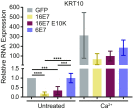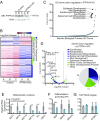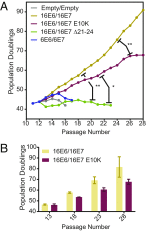PTPN14 degradation by high-risk human papillomavirus E7 limits keratinocyte differentiation and contributes to HPV-mediated oncogenesis
- PMID: 30894485
- PMCID: PMC6452706
- DOI: 10.1073/pnas.1819534116
PTPN14 degradation by high-risk human papillomavirus E7 limits keratinocyte differentiation and contributes to HPV-mediated oncogenesis
Abstract
High-risk human papillomavirus (HPV) E7 proteins enable oncogenic transformation of HPV-infected cells by inactivating host cellular proteins. High-risk but not low-risk HPV E7 target PTPN14 for proteolytic degradation, suggesting that PTPN14 degradation may be related to their oncogenic activity. HPV infects human keratinocytes but the role of PTPN14 in keratinocytes and the consequences of PTPN14 degradation are unknown. Using an HPV16 E7 variant that can inactivate retinoblastoma tumor suppressor (RB1) but cannot degrade PTPN14, we found that high-risk HPV E7-mediated PTPN14 degradation impairs keratinocyte differentiation. Deletion of PTPN14 from primary human keratinocytes decreased keratinocyte differentiation gene expression. Related to oncogenic transformation, both HPV16 E7-mediated PTPN14 degradation and PTPN14 deletion promoted keratinocyte survival following detachment from a substrate. PTPN14 degradation contributed to high-risk HPV E6/E7-mediated immortalization of primary keratinocytes and HPV+ but not HPV- cancers exhibit a gene-expression signature consistent with PTPN14 inactivation. We find that PTPN14 degradation impairs keratinocyte differentiation and propose that this contributes to high-risk HPV E7-mediated oncogenic activity independent of RB1 inactivation.
Keywords: HPV; PTPN14; carcinogenesis; differentiation; papillomavirus.
Conflict of interest statement
The authors declare no conflict of interest.
Figures








Similar articles
-
A Conserved Amino Acid in the C Terminus of Human Papillomavirus E7 Mediates Binding to PTPN14 and Repression of Epithelial Differentiation.J Virol. 2020 Aug 17;94(17):e01024-20. doi: 10.1128/JVI.01024-20. Print 2020 Aug 17. J Virol. 2020. PMID: 32581101 Free PMC article.
-
High-Risk Human Papillomavirus E7 Proteins Target PTPN14 for Degradation.mBio. 2016 Sep 20;7(5):e01530-16. doi: 10.1128/mBio.01530-16. mBio. 2016. PMID: 27651363 Free PMC article.
-
HPV18 E7 inhibits LATS1 kinase and activates YAP1 by degrading PTPN14.mBio. 2024 Oct 16;15(10):e0181124. doi: 10.1128/mbio.01811-24. Epub 2024 Sep 9. mBio. 2024. PMID: 39248565 Free PMC article.
-
The PTPN14 Tumor Suppressor Is a Degradation Target of Human Papillomavirus E7.J Virol. 2017 Mar 13;91(7):e00057-17. doi: 10.1128/JVI.00057-17. Print 2017 Apr 1. J Virol. 2017. PMID: 28100625 Free PMC article.
-
The human papillomavirus late life cycle and links to keratinocyte differentiation.J Med Virol. 2024 Feb;96(2):e29461. doi: 10.1002/jmv.29461. J Med Virol. 2024. PMID: 38345171 Review.
Cited by
-
Human Papillomavirus 42 Drives Digital Papillary Adenocarcinoma and Elicits a Germ Cell-like Program Conserved in HPV-Positive Cancers.Cancer Discov. 2023 Jan 9;13(1):70-84. doi: 10.1158/2159-8290.CD-22-0489. Cancer Discov. 2023. PMID: 36213965 Free PMC article.
-
HPV Infections-Classification, Pathogenesis, and Potential New Therapies.Int J Mol Sci. 2024 Jul 11;25(14):7616. doi: 10.3390/ijms25147616. Int J Mol Sci. 2024. PMID: 39062859 Free PMC article. Review.
-
ZER1 Contributes to the Carcinogenic Activity of High-Risk HPV E7 Proteins.mBio. 2022 Dec 20;13(6):e0203322. doi: 10.1128/mbio.02033-22. Epub 2022 Nov 8. mBio. 2022. PMID: 36346242 Free PMC article.
-
A Conserved Amino Acid in the C Terminus of Human Papillomavirus E7 Mediates Binding to PTPN14 and Repression of Epithelial Differentiation.J Virol. 2020 Aug 17;94(17):e01024-20. doi: 10.1128/JVI.01024-20. Print 2020 Aug 17. J Virol. 2020. PMID: 32581101 Free PMC article.
-
FAT1 and PTPN14 Regulate the Malignant Progression and Chemotherapy Resistance of Esophageal Cancer through the Hippo Signaling Pathway.Anal Cell Pathol (Amst). 2021 Oct 19;2021:9290372. doi: 10.1155/2021/9290372. eCollection 2021. Anal Cell Pathol (Amst). 2021. PMID: 34712552 Free PMC article.
References
-
- Graham SV. The human papillomavirus replication cycle, and its links to cancer progression: A comprehensive review. Clin Sci (Lond) 2017;131:2201–2221. - PubMed
-
- Muñoz N, et al. International Agency for Research on Cancer Multicenter Cervical Cancer Study Group Epidemiologic classification of human papillomavirus types associated with cervical cancer. N Engl J Med. 2003;348:518–527. - PubMed
Publication types
MeSH terms
Substances
Grants and funding
LinkOut - more resources
Full Text Sources
Molecular Biology Databases
Research Materials
Miscellaneous

